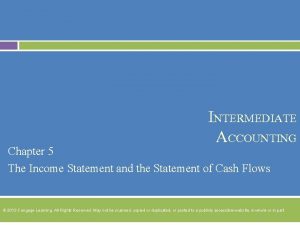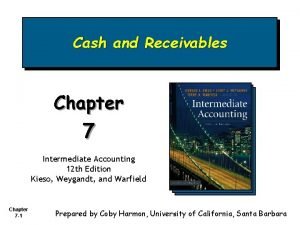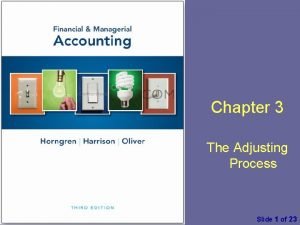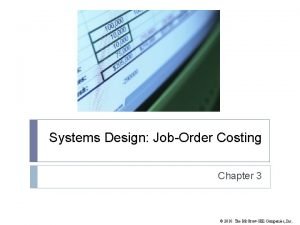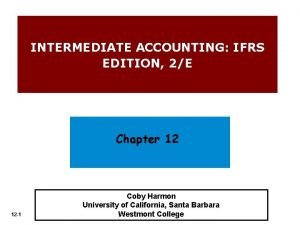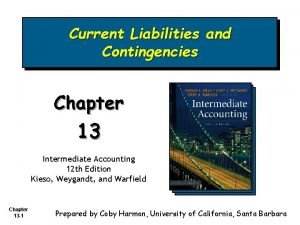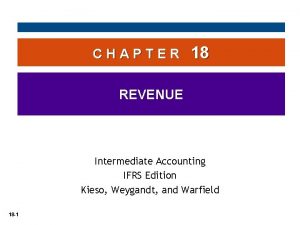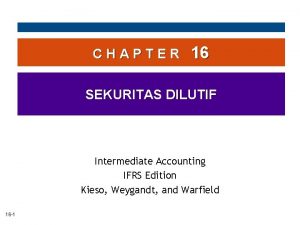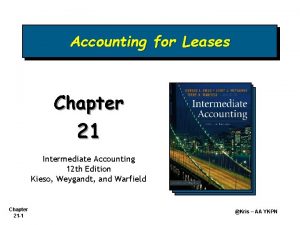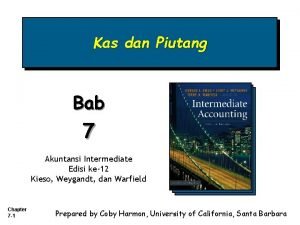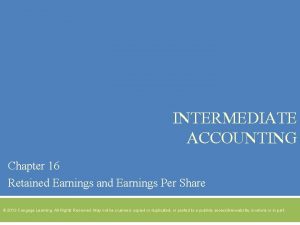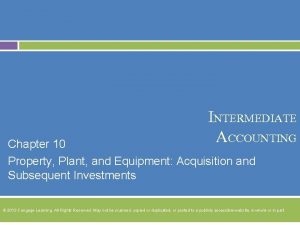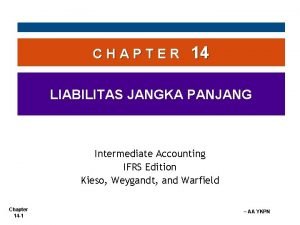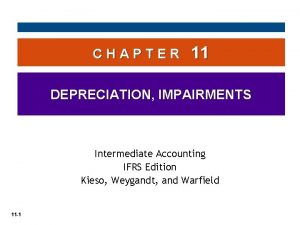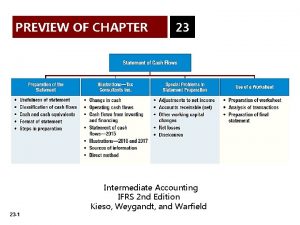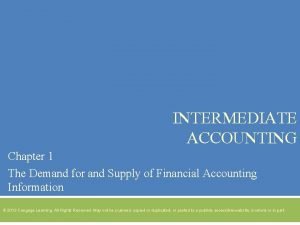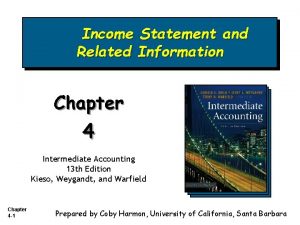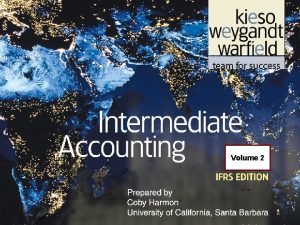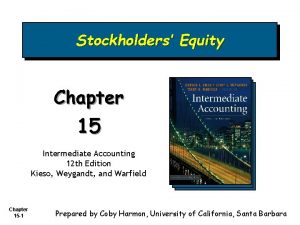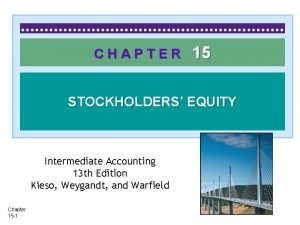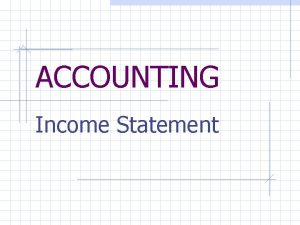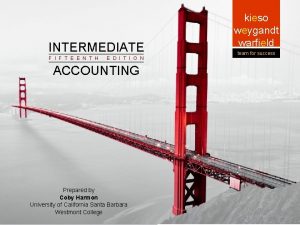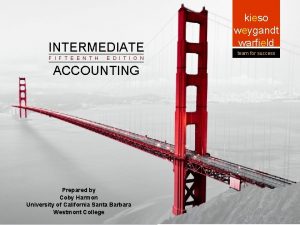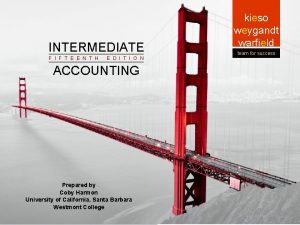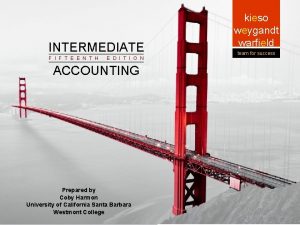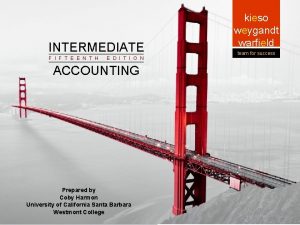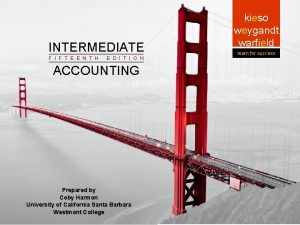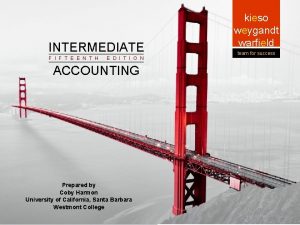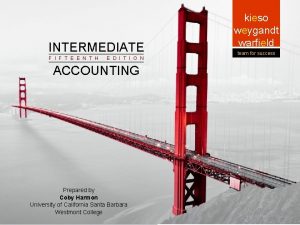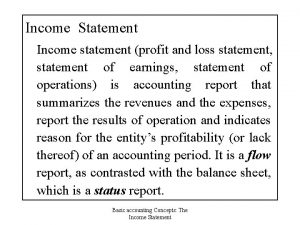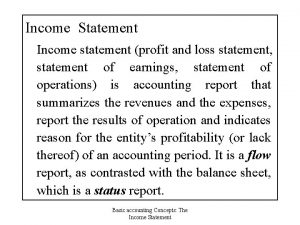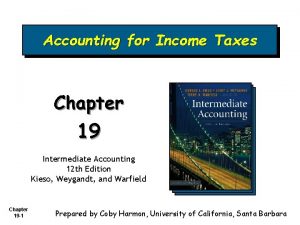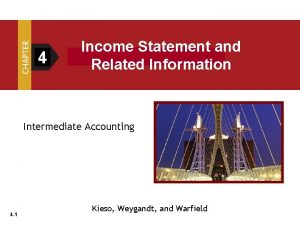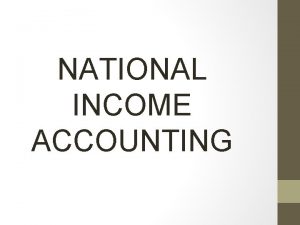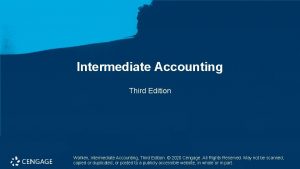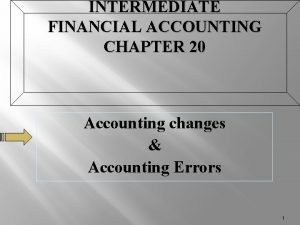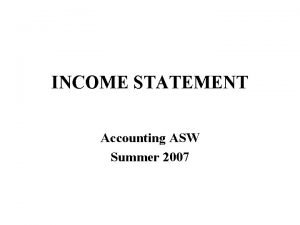INTERMEDIATE ACCOUNTING Chapter 5 The Income Statement and



































- Slides: 35

INTERMEDIATE ACCOUNTING Chapter 5 The Income Statement and the Statement of Cash Flows © 2013 Cengage Learning. All Rights Reserved. May not be scanned, copied or duplicated, or posted to a publicly accessible website, in whole or in part.

The Importance of Earnings • While the balance sheet represents a company’s financial position at a moment in time, the income statement represents its financial performance for a defined period The income statement reports how well the organization performed in generating revenues, incurring expenses, and creating profits for investors, lenders, creditors, and other stakeholders • Stock analysts (reporting to investors) develop forecasts for quarterly and annual earnings numbers • Management faces intense pressure to generate earnings numbers that will please investors and stakeholders and is commonly compensated based on the company meeting or exceeding certain earnings targets established by the board © 2013 Cengage Learning. All Rights Reserved. May not be scanned, copied or duplicated, or posted to a publicly accessible website, in whole or in part. of directors •

What are the Purposes of the Income Statement? • • Evaluate the profitability and assess the return on investment in the company Assess the company’s operating capability and financial performance for the current period and over time Evaluate management’s performance Predict the company’s future income and cash flows Understand the components of income Assess the company’s risk Compare performance against other companies Assess the impact of economic factors on the company © 2013 Cengage Learning. All Rights Reserved. May not be scanned, copied or duplicated, or posted to a publicly accessible website, in whole or in part.

Income, Comprehensive Income, and Net Income • The capital maintenance concept states that a corporation’s net income for a period of time is the amount that it could distribute to shareholders without depleting the capital the shareholders have invested (not a return of capital) • Companies are required to measure and report both net income and comprehensive income • Comprehensive income is the change in equity of a company during a period from transactions, other events, and circumstances relating to nonowner sources. It includes all changes in equity during a period except those resulting from investments by owners and distributions to owners. • Net income measures accomplishments (resources created) and efforts (resources used up) so that the reported net income reflects the results of the company’s income-generating activities. In the accrual approach, a corporation’s net income for a period is © 2013 Cengage Learning. All Rightsas Reserved. May not be scanned, copied or duplicated, or posted to a publicly accessible website, in whole or in part. measured follows:

What are the Elements of the Income Statement? • The four elements of the income statement are • Revenues • Expenses • Gains • Losses © 2013 Cengage Learning. All Rights Reserved. May not be scanned, copied or duplicated, or posted to a publicly accessible website, in whole or in part.

Revenues • Revenues are increases in assets or settlements of liabilities from delivering or producing goods, rendering services, or other activities that are the company’s ongoing major or central operations • They represent increases in future economic benefits from increases in cash, accounts receivable or other types of assets, or settlements of performance obligations to customers who have paid in advance for goods or services • They measure the accomplishments of the operating activities in producing and delivering goods and services to customers • Transactions that result in revenues are varied depending on © 2013 Cengage Learning. All Rights Reserved. May not be scanned, copied or duplicated, or posted to a publicly accessible website, in whole or in part.

Revenue Recognition • Revenue recognition is the process of formally measuring and reporting revenue in a company’s financial statements • Revenue recognition principles are a matter of timing. In general, revenue cannot be recognized until both: 1. it has been earned • The company has produced and delivered the goods or services to its customers and has earned the rights to the asset being created or has settled the liability to a customer 2. collection has occurred or is reasonably certain to occur • Future economic benefits associated with created assets have been realized (received cash settling accounts receivable) or © 2013 Cengage Learning. All Rights Reserved. May not be scanned, copied or duplicated, or posted to a publicly accessible website, in whole or in part. are reasonably certain to be realized in the future

Revenue Recognition Relative to Cash Flows © 2013 Cengage Learning. All Rights Reserved. May not be scanned, copied or duplicated, or posted to a publicly accessible website, in whole or in part.

Expenses • Expenses arise from outflows or using up assets or incurring liabilities (or a combination of both) from delivering or producing goods, rendering services, or carrying out other activities that are the company’s ongoing major or central operations • Within accrual accounting, expenses are measured and recognized in the period in which the resources are used up, the outflows of assets occur, or the liabilities are incurred, even though the cash outflows may occur in a different period (expense recognition) • The FASB has identified the following expense recognition principles: • Association of Cause and Effect • Systematic and Rational Allocation • Immediate Recognition © 2013 Cengage Learning. All Rights Reserved. May not be scanned, copied or duplicated, or posted to a publicly accessible website, in whole or in part.

Expenditure: Asset or Expense? © 2013 Cengage Learning. All Rights Reserved. May not be scanned, copied or duplicated, or posted to a publicly accessible website, in whole or in part.

Gains and Losses • Gains and losses are components of net income. They are reported “net” and generally in the period the event occurred. • Gains are increases in the equity (net assets) of a company from peripheral or incidental transactions… not revenue or equity investments • Losses are decreases in the equity (net assets) of a company from peripheral or incidental transactions… not expenses or dividends • Revenues and expenses relate to a company’s major operating activities while gains and losses relate to peripheral activities (selling fixed assets for more or less than book value) or to the effects of other events and circumstances, some of which may be beyond its control © 2013 Cengage Learning. All Rights Reserved. May not be scanned, copied or duplicated, or posted to a publicly accessible website, in whole or in part.

What Are the Major Components of the Income Statement? • Although the form of the income statement may differ from company to company, its content is relatively standard. The major components and items are: • Revenues • Cost of goods sold, Operating expenses, Other operating income items (gains and losses) • Operating income • Interest expense, Interest and dividend income, Unusual and nonrecurring gains and losses, Income taxes associated with continuing operations • Income from continuing operations • Results from discontinued operations, Income (loss) from operations of discontinued components (net of income taxes), Gain (loss) from disposals of discontinued components (net of income taxes) • Extraordinary items (net of income taxes) • Net income © 2013 Cengage Learning. All Rights Reserved. May not be scanned, copied or duplicated, or posted to a publicly accessible website, in whole or in part.

How Do Income Statements Report Operating Income and Income from Continuing Operations? • Operating income (loss) includes sales revenue, the various expenses related to these sales and business activities, and other income items related to operating activities. • Income from continuing operations reports the company’s income from ongoing, recurring business activities • It includes operating income plus (or minus) income items associated with financing and investing activities (such as interest expense and interest income); gains and losses that are not part of normal, ongoing operating activities; and income taxes • It excludes the income effects of items that are not continuing, either because they are components of the business that are © 2013 Cengage Learning. All Rights Reserved. May not be scanned, copied or duplicated, or posted to a publicly accessible website, in whole or in part.

Sales Revenue • Gross sales revenues (or gross revenues) are total increases in assets or settlements of liabilities from delivering or producing goods, rendering services, or other activities that are the company’s ongoing major or central operations • Net sales revenues (or net revenues) are the gross sales revenues minus any sales returns or allowances and any sales discount given to customers (or reasonably estimated) • Net sales amounts typically exclude any sales taxes or value added taxes the company may have collected from customers because the company will have to remit them to the taxing authority. © 2013 Cengage Learning. All Rights Reserved. May not be scanned, copied or duplicated, or posted to a publicly accessible website, in whole or in part.

Cost of Goods Sold and Operating Expenses • Cost of goods sold is the cost of the inventory items sold to customers during the period. • In a perpetual inventory system, the cost of goods sold is recorded at the time of each sale and reports the total for the period on its income statement • In a periodic inventory system, the cost of goods sold is based on a physical inventory taken at the end of each period (cost of goods available – ending inventory) • Operating expenses are those primary recurring costs incurred to generate sales revenues and conduct business operations • Typically classified according to functional categories… for example selling expenses separated from general and administrative expenses • Because of their significance, depreciation, amortization, research and development expenses may also be shown as a © 2013 Cengage Learning. All Rights Reserved. May not be scanned, copied or duplicated, or posted to a publicly accessible website, in whole or in part. separate categories

Other Operating Income and Expense Items • Gains and losses from asset sales, inventory write-downs, impairment charges, restructuring charges, or other types of gains and losses that are a consequence of normal operating activities are included in operating income • Significant recurring items of income and expense, as well as gains and losses, which are not directly related to the primary operations but result from the financing and investing activities • Gains and losses that are unusual and nonrecurring “nonextraordinary” and not a consequence of normal operating activities © 2013 Cengage Learning. All Rights Reserved. May not be scanned, copied or duplicated, or posted to a publicly accessible website, in whole or in part.

Income Taxes • Pretax income from continuing operations is reported before income tax expense • Operating income plus or minus interest expense, interest and dividend income, other gains and losses, and any unusual or nonrecurring gains and losses • Income tax expense related to continuing operations represents an accrued expense for the total amount of income tax (federal, state, and foreign) that a corporation will ultimately have to pay on the income generated during the period • Interperiod tax allocation involves assigning a corporation’s tax obligation as an expense across various accounting periods because of temporary (timing) differences between its taxable income and pretax financial income • Intraperiod tax allocation involves apportioning a corporation’s total income tax expense for a period to the various components © 2013 Cengage Learning. All Rights Reserved. May not be scanned, copied or duplicated, or posted to a publicly accessible website, in whole or in part. of its net income and other comprehensive income items (if any)

Net Income Attributable to Noncontrolling Interests • Noncontrolling interests only arises when a parent company owns a majority of the common shares of a subsidiary company but does not own 100% of the shares. In a situation like this, the parent company will consolidate 100% of the subsidiary company’s income statement with its own income statement, including all of the revenues, expenses, and net income of the subsidiary. However, the noncontrolling shareholders are entitled to a minority portion of the subsidiary’s earnings. © 2013 Cengage Learning. All Rights Reserved. May not be scanned, copied or duplicated, or posted to a publicly accessible website, in whole or in part.

How Do Income Statements Report Results from Discontinued Operations? • A company reports results from discontinued operations when: • operations and cash flows of the component have been eliminated • company will have no significant continuing involvement in the operations of the component after the disposal • A component of a company involves operations and cash flows that can be distinguished, operationally and for financial reporting purposes, from the rest of the company. • A company must distinguish (based on management’s judgment) the sale of a component from the sale of other assets, as well as from other activities related to © 2013 Cengage Learning. All Rights Reserved. May not be scanned, copied or duplicated, or posted to a publicly accessible website, in whole or in part. restructuring or changing the company’s business, such

Operating Income (or Loss) of a Discontinued Operation • When a component of a company operates during part of a year and then is sold before the end of the year, it has operating income or an operating loss for part of the year • This must be distinguished separately from the income from continuing operations of the rest of the company © 2013 Cengage Learning. All Rights Reserved. May not be scanned, copied or duplicated, or posted to a publicly accessible website, in whole or in part.

Gain or Loss on Sale of a Discontinued Operation (Slide 1 of 2) • When the sale occurs in the same accounting period that management decided to sell the component, the calculation of the pretax gain (loss) is determined by subtracting the book value of the net assets (assets minus liabilities) of the component from the net proceeds received (selling price minus any selling costs). • A company classifies a component as held for sale at the end of the current accounting period when all of the following criteria are met: • Management has committed to a plan to sell the component, the component is available for immediate sale in its present condition, management has begun an active program to locate a buyer, the sale is probable within one year, the component is being offered for sale at a price that is reasonable in relation to the component’s current fair value and it is unlikely that © 2013 Cengage Learning. All Rights Reserved. will May notmake be scanned, copied or duplicated, or posted to a publicly accessible website, in whole or in part. management significant changes to the plan

Gain or Loss on Sale of a Discontinued Operation (Slide 2 of 2) • A component classified as held for sale is reported on its balance sheet at the lower of (1) its book value (book value of assets minus book value of liabilities) or (2) its fair value minus any costs to sell. If the fair value (minus any costs to sell) is less than the book value, the company records a loss and adjusts the book values of the assets of the component. • The loss (after taxes) is reported in the results from discontinued operations section of its income statement. It reports the assets and the liabilities in the respective sections of its ending balance sheet. • When the company actually completes the sale of a held-forsale component, it computes any additional gain (loss) on the sale by subtracting the adjusted net book value of the component from the net proceeds received. © 2013 Cengage Learning. All Rights Reserved. May not be scanned, copied or duplicated, or posted to a publicly accessible website, in whole or in part.

Disclosures • A company is also required to disclose certain information about the sale (or classification as held for sale) of a discontinued component in the notes to its financial statements. This information includes: • a description of the facts and circumstances leading up to the sale and, if held for sale, the expected manner and timing of the sale • the revenues and pretax income (loss) of the component included in its operating income (loss) reported in the results from discontinued operations section of the company’s income statement • if not separately reported on its income statement, the gain (loss) on the sale and the caption on the income statement that includes the gain (loss) if not separately reported on orits balance the book © 2013 Cengage • Learning. All Rights Reserved. May not be scanned, copied duplicated, or postedsheet, to a publicly accessible website, values in whole or inof part.

How Do We Report Extraordinary Items on the Income Statement? • U. S. GAAP establishes very narrow criteria that must be met for an event to be classified as extraordinary. IFRS do not permit gains or losses to be labeled extraordinary. • An extraordinary item is an event or a transaction that is unusual in nature and infrequent in occurrence. • Both of the following criteria must be met • Unusual in nature—the underlying event or transaction is highly abnormal and is clearly unrelated to, or only incidentally related to, the ordinary and typical activities of the company, taking into account the environment in which the company operates. • Infrequent in occurrence—the underlying event or transaction is not reasonably expected to recur in the foreseeable future, taking into account the environment in which the company © 2013 Cengage Learning. All Rights Reserved. May not be scanned, copied or duplicated, or posted to a publicly accessible website, in whole or in part.

Reporting Gains or Losses in Income © 2013 Cengage Learning. All Rights Reserved. May not be scanned, copied or duplicated, or posted to a publicly accessible website, in whole or in part.

How Do Companies Report Comprehensive Income? • Under U. S. GAAP, there are four items of other comprehensive income: • unrealized increases (gains) or decreases (losses) in the fair value of available-for-sale investment securities • certain types of gains, losses, and prior service cost adjustments to net pension plan assets and liabilities • gains and losses on derivative financial instruments that hedge future cash flows • translation adjustments from converting the financial statements of foreign subsidiaries into U. S. dollars • Under U. S. GAAP and IFRS, a company can report its comprehensive income (or loss) under two alternatives: • present net income and comprehensive income in a single continuous performance statement OR • present net income on the income statement and present comprehensive income on acopied separate, consecutive, statement ofor in part. © 2013 Cengage Learning. All Rights Reserved. May not be scanned, or duplicated, but or posted to a publicly accessible website, in whole

The Relationships between Shareholders’ Equity, Net Income and Comprehensive Income © 2013 Cengage Learning. All Rights Reserved. May not be scanned, copied or duplicated, or posted to a publicly accessible website, in whole or in part.

Overview and Uses of the Statement of Cash Flows • When used with a company’s other financial statements, the statement of cash flows helps external users assess the company’s: • • ability to generate positive future cash flows from operations ability to meet its obligations use of cash for capital expenditures and investments capital raised from external financing sources and repayments of external financing • differences between the company’s net income and associated cash receipts and payments • sources of cash from issuing shares and uses of cash to pay dividends and repurchase shares from common shareholders © 2013 Cengage Learning. All Rights Reserved. May not be scanned, copied or duplicated, or posted to a publicly accessible website, in whole or in part.

Reporting the Statement of Cash Flows • Both U. S. GAAP and IFRS require that a company provide a statement of cash flows to report on a company’s cash inflows, cash outflows, and net change in cash from its operating, investing, and financing activities during the accounting period, in a manner that reconciles the beginning and ending cash balances (from the balance sheet). • Three major sections: • Operating activities include all the transactions and other events related to its primary business activities, such as those involved in purchasing, producing, selling, and delivering goods for sale, as well as providing services. • Investing activities include transactions involving buying and selling property, plant, and equipment and intangible assets; buying and selling long-term investments; and lending money and collecting on the loans. • Financing activities include transactions involved in obtaining resources from owners and paying dividends and repurchasing shares, as well as © 2013 Cengage Learning. All Rights Reserved. May not be scanned, copied or duplicated, or posted to a publicly accessible website, in whole or in part. obtaining resources from lenders and repaying the amounts borrowed.

Operating, Investing and Financing Activity Cash Flows © 2013 Cengage Learning. All Rights Reserved. May not be scanned, copied or duplicated, or posted to a publicly accessible website, in whole or in part.

Operating Activities: Indirect Method • The Operating Activities section reports the cash receipts and payments from the operating activities of the company. • The most common way to prepare this section is called the indirect method. • Net income is listed first and then adjustments (additions or subtractions) are made: • Reverse out the effect of certain non-cash transaction, such as depreciation expense and amortization expense, that were included in net income • Include the cash flow effects triggered by changes in the period in current assets (other than cash) and current liabilities © 2013 Cengage Learning. All Rights Reserved. May not be scanned, copied or duplicated, or posted to a publicly accessible website, in whole or in part.

Investing Activities and Financing Activities • The Investing Activities section includes all the cash inflows and outflows involved in the investing activities of the company • Receipts from selling and payments for purchasing property, plant, and equipment • Receipts from selling and payments for purchasing investments in stocks and debt securities • The Financing Activities section includes all the cash inflows and cash outflows involved in the financing activities of the company • Receipts from the issuance of debt securities (e. g. , bonds, mortgages, notes) and cash disbursement to repay debt obligations Receipts from. Maythe shares payments toin whole or in part. © 2013 Cengage • Learning. All Rights Reserved. not beissuance scanned, copied orof duplicated, or postedand to a publicly accessible website,

Operating Activities: Direct Method • While the FASB encourages use of the direct method, relatively few companies use this method. • This method separates operating cash inflows from operating cash outflows, which may be useful in estimating future cash flows. • The most common cash inflows and outflows for operating activities are: • operating cash inflows • collections from customers • interest and dividends collected • operating cash outflows • payments to suppliers and employees • payments of interest and income taxes © 2013 Cengage Learning. All Rights Reserved. May not be scanned, copied or duplicated, or posted to a publicly accessible website, in whole or in part.

Components of Comprehensive Income and Cash Flow (Slide 1 of 2) © 2013 Cengage Learning. All Rights Reserved. May not be scanned, copied or duplicated, or posted to a publicly accessible website, in whole or in part.

Components of Comprehensive Income and Cash Flow (Slide 2 of 2) © 2013 Cengage Learning. All Rights Reserved. May not be scanned, copied or duplicated, or posted to a publicly accessible website, in whole or in part.
 Chapter 5 intermediate accounting
Chapter 5 intermediate accounting Carrying amount formula
Carrying amount formula Accounting income vs taxable income
Accounting income vs taxable income Financial statement of comprehensive income
Financial statement of comprehensive income Bearing note
Bearing note Income statement in financial accounting
Income statement in financial accounting Cost accounting income statement
Cost accounting income statement Chapter 15 intermediate accounting
Chapter 15 intermediate accounting Chapter 17 intermediate accounting solutions
Chapter 17 intermediate accounting solutions Kunci jawaban intermediate accounting chapter 12
Kunci jawaban intermediate accounting chapter 12 Gain contingencies
Gain contingencies Intermediate accounting chapter 18
Intermediate accounting chapter 18 Chapter 16 kieso
Chapter 16 kieso Kieso intermediate accounting chapter 21 solutions
Kieso intermediate accounting chapter 21 solutions Tax loss carry forward
Tax loss carry forward Bab 7 kas dan piutang
Bab 7 kas dan piutang Intermediate accounting chapter 16
Intermediate accounting chapter 16 Chapter 10 property plant and equipment
Chapter 10 property plant and equipment Chapter 2 conceptual framework
Chapter 2 conceptual framework Liabilitas jangka pendek
Liabilitas jangka pendek Chapter 11 intermediate accounting
Chapter 11 intermediate accounting Chapter 3 intermediate accounting
Chapter 3 intermediate accounting Intermediate accounting chapter 15
Intermediate accounting chapter 15 Financial accounting and accounting standards chapter 1
Financial accounting and accounting standards chapter 1 Chapter 13 intermediate accounting
Chapter 13 intermediate accounting Intermediate accounting chapter 2
Intermediate accounting chapter 2 Retail inventory method
Retail inventory method Chapter 23 statement of cash flows
Chapter 23 statement of cash flows Intermediate accounting chapter 1
Intermediate accounting chapter 1 Contoh soal laporan ekuitas pemegang saham
Contoh soal laporan ekuitas pemegang saham Chapter 21 intermediate accounting
Chapter 21 intermediate accounting Income statement kieso
Income statement kieso Intermediate accounting chapter 1
Intermediate accounting chapter 1 Under ifrs the presumption is that equity investments are
Under ifrs the presumption is that equity investments are Property dividend
Property dividend Chapter 15 stockholders equity
Chapter 15 stockholders equity
